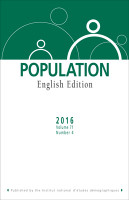
Population 2016, n°4
2016
Jorik Vergauwen, Karel Neels, Jonas Wood
The Life Expectancy of Medical Professionals in the Netherlands, Sixteenth to Twentieth Centuries
Frans van Poppel, Govert Bijwaard, Mart van Lieburg, Fred van Lieburg, Rik Hoekstra, Frans Verkade
Son preference in a Sharecropping Society. Gender Composition of Children an d Reproduction in a Pre-Transitional Italian Community
Matteo Manfredini, Marco Breschi, Alessio Fornasin
Fertility Transition in Bhutan : An assessment
Tashi Dorjee, Thomas Spoorenberg
Seventieth Anniversary of Population
Wilfried Rault and Arnaud Régnier-Loilier present and analyse an article by Jean Bourgeois published in 1946
Gender: History, Inequalities (2)
Jorik Vergauwen, Karel Neels, Jonas Wood
Delayed union formation has been suggested as one of the main pathways through which economic conditions affect fertility. The link between (un)employment and union formation has received limited attention in the literature, however. Using longitudinal micro-data from the first and second waves of the Generations and Gender Survey, in tandem with contextual data on unemployment rates, multilevel discrete-time hazard models are estimated to assess how individual employment status and aggregate-level economic conditions have affected entry into a first co-residential union of young adults in France (1993-2008). We focus on whether the association between individual-level employment status and aggregate-level unemployment rates on the one hand, and union formation on the other, differs by gender and level of education. For men, we find that not being employed reduces the probability of entering a co-residential union, whatever their level of education. Among women, not being employed delays union formation only for those with tertiary education. A higher aggregate-level unemployment rate negatively affects the probability of entering a co-residential union among tertiary educated men, but no association is found among women.
• The Life Expectancy of Medical Professionals in the Netherlands, Sixteenth to Twentieth Centuries
Frans van Poppel, Govert Bijwaard, Mart van Lieburg, Fred van Lieburg, Rik Hoekstra, Frans Verkade
Rising life expectancy has been suggested as a determining factor behind the start of modern economic growth. On the basis of information relating to elite groups, economic historians have thus questioned the idea, prevalent among most demographers, that life expectancy remained quite stable until around 1800. There still is a scarcity of data on the long-term evolution of life expectancy able to support this claim. We present data on medical professionals in the Netherlands to study the evolution of life expectancy at age 25 in birth cohorts from the sixteenth to the early twentieth centuries. We compare the medical professions with groups without formal medical knowledge – clergymen, visual artists, notable Dutch people, and members of the nobility and patriciate – thereby providing clues about the role of medicine as a factor behind the mortality decline. We used event history models to estimate the length of life. We observe very strong increases in survival in all selected groups,
starting in the cohorts born in the seventeenth century. While medical professionals were no exception to this trend, their life expectancy did not increase faster than that of other groups; for a long time, medical knowledge seems to have provided only limited advantages to those who possessed it.
• Son preference in a Sharecropping Society. Gender Composition of Children an d Reproduction in a Pre-Transitional Italian Community
Matteo Manfredini, Marco Breschi, Alessio Fornasin
Sex preference, and its association with fertility, has been frequently, if not exclusively, studied for transitional and post-transitional populations. Many studies have concerned Asian countries, where patriarchal families and gender discrimination were common cultural traits favouring preference for sons. Conversely, little attention has been paid to pretransitional populations, where it was believed that couples’ sex preferences were met because of their larger average completed family size. However, the pretransitional Italian sharecropping society shares the same cultural features as some contemporary Asian societies, such as patriarchal families, strong gender inequality, and a rigid gender division of work within the household that led to sons being valued over daughters. This article investigates the relationship between sex composition of surviving children and fertility in a sharecropping population of mid-nineteenth-century Tuscany. The analysis is based on the longitudinal reproductive life-histories of the women living in Casalguidi between 1819 and 1859.
• Fertility Transition in Bhutan : An assessment
Tashi Dorjee, Thomas Spoorenberg
Due to Bhutan’s geographical location, its historical isolation and the small number of available data sources, little is known about the country’s demographic development. This short paper reviews and examines the evidence documenting the changes in fertility levels and trends in Bhutan over the last 50 years in order to lay empirical foundations for further research on fertility change in the country. Using the available census and sample survey data, direct and indirect methods are applied to estimate fertility. Despite variations between estimation methods, the different series give a rather consistent picture of the fertility change. The reconstruction of the fertility levels and trends in Bhutan shows that the total fertility rate was around 6 children per woman until the mid-1980s and fell rapidly from about 5.5 children per woman in the 1990s to close to
replacement level today.
Prix TTC : 20,00 €

